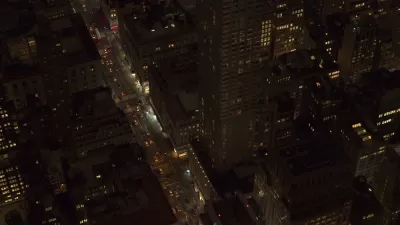The city that never sleeps depends on 396,572 street lights. As bright white LEDs replace the familiar amber glow, what does tomorrow (night) hold?

New York’s nightscape is as iconic (think film noir street corners and neon glitterati escapades) as it is taken for granted. A city without streetlights is impossible to imagine, but New York’s 396,572 street-side luminaires are as unremarkable as the streets’ paving — invisible until something changes. An initiative to replace sodium and halogen bulbs with energy- and cost-efficient LEDs has thrown the nightscape suddenly into question, as some city residents bemoan the loss of romance (and sleep). Nocturnal animals, too, are finding the conversion hard to take. But the iconic and under-appreciated nighttime infrastructure is also essential to the modern city. In New York, “nightlife” generates 300,000 jobs and $10 billion annually, and the recent establishment of an Office of Nightlife and the appointment of a new “night mayor” signals intention to give after-dark the same consideration as the daily grind. LEDs could be a boon for that industry, and for others who prefer to stay out late. SWA’s innovation lab, xl studied New York’s LED conversion for its impacts on the “Urban Sensorium”; below, Emily Schlickman explains what’s going on, what’s to come, and what it all could mean for the night and its many inhabitants.
FULL STORY: Illuminated Futures

Alabama: Trump Terminates Settlements for Black Communities Harmed By Raw Sewage
Trump deemed the landmark civil rights agreement “illegal DEI and environmental justice policy.”

Study: Maui’s Plan to Convert Vacation Rentals to Long-Term Housing Could Cause Nearly $1 Billion Economic Loss
The plan would reduce visitor accommodation by 25% resulting in 1,900 jobs lost.

Planetizen Federal Action Tracker
A weekly monitor of how Trump’s orders and actions are impacting planners and planning in America.

Wind Energy on the Rise Despite Federal Policy Reversal
The Trump administration is revoking federal support for renewable energy, but demand for new projects continues unabated.

Passengers Flock to Caltrain After Electrification
The new electric trains are running faster and more reliably, leading to strong ridership growth on the Bay Area rail system.

Texas Churches Rally Behind ‘Yes in God’s Back Yard’ Legislation
Religious leaders want the state to reduce zoning regulations to streamline leasing church-owned land to housing developers.
Urban Design for Planners 1: Software Tools
This six-course series explores essential urban design concepts using open source software and equips planners with the tools they need to participate fully in the urban design process.
Planning for Universal Design
Learn the tools for implementing Universal Design in planning regulations.
Caltrans
Smith Gee Studio
Institute for Housing and Urban Development Studies (IHS)
City of Grandview
Harvard GSD Executive Education
Toledo-Lucas County Plan Commissions
Salt Lake City
NYU Wagner Graduate School of Public Service




























